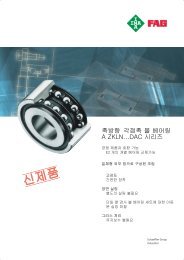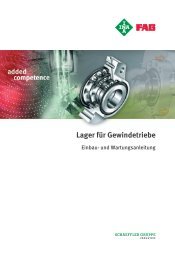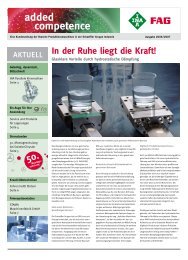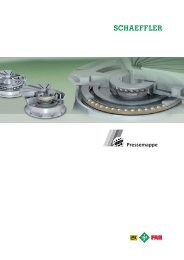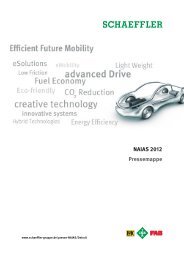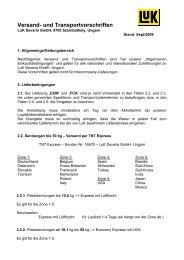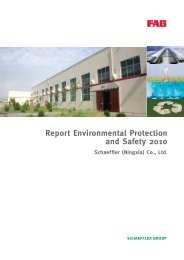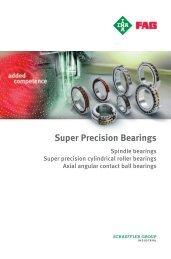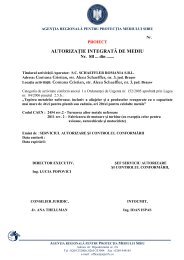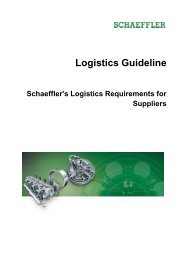Double clutch
Double clutch
Double clutch
Create successful ePaper yourself
Turn your PDF publications into a flip-book with our unique Google optimized e-Paper software.
LuK SYMPOSIUM 2006<br />
<strong>Double</strong> <strong>clutch</strong> –<br />
Wet or dry,<br />
that is the question<br />
Karl-Ludwig Kimmig<br />
Ivo Agner<br />
119
9 <strong>Double</strong> <strong>clutch</strong><br />
Introduction<br />
<strong>Double</strong> <strong>clutch</strong> transmissions for passenger<br />
vehicles are currently occupying the attention<br />
of development departments in the automotive<br />
and supplier industries. The driving force is the<br />
improvement in fuel consumption available<br />
from current manual transmissions together<br />
with the comfort of automatic transmissions. In<br />
order that the new generation of transmissions<br />
can function with the highly effective gearshift<br />
and synchronisation devices of manual transmissions,<br />
two <strong>clutch</strong>es that can be independently<br />
operated, are required [1]. Each of the two<br />
<strong>clutch</strong>es links one subtransmission to the internal<br />
combustion engine, a function that can be<br />
fulfilled in principle by wet or dry <strong>clutch</strong>es. Both<br />
<strong>clutch</strong>es must be operated by automated<br />
means in order to control the gearshift operations<br />
without interruptions to starting or traction<br />
force.<br />
Figure 1 Dry and wet double <strong>clutch</strong><br />
Which <strong>clutch</strong> system (wet or dry) represents the<br />
better solution for a generation of vehicles is currently<br />
the subject of intense discussion in the<br />
technical arena (figure 1). LuK has experience<br />
with both dry and wet <strong>clutch</strong>es and therefore<br />
wishes to address this subject without the oft<br />
stated prejudices against each system, but without<br />
making any claim to completeness.<br />
The opinions commonly expressed in the technical<br />
arena are presented below. The dry <strong>clutch</strong><br />
has only limited thermal capacity, so that under<br />
large energy inputs the system quickly reaches<br />
its limits, which are significantly below those of<br />
comparable automatic torque converters or wet<br />
<strong>clutch</strong>es. Furthermore, wear of the dry friction<br />
lining is often a point of discussion where questions<br />
of service life are concerned.<br />
The wet <strong>clutch</strong> in combination with a fully hydraulic<br />
control system for actuation and cooling is generally<br />
regarded as too demanding and expensive.<br />
Furthermore, the pump losses often lead to higher<br />
fuel consumption compared to dry solutions.<br />
120 LuK SYMPOSIUM 2006
Figure 2 Comparison of passively closed / actively closed <strong>clutch</strong><br />
The dry<br />
double <strong>clutch</strong><br />
Due to the construction of powershift transmissions,<br />
safety reasons dictate that the <strong>clutch</strong>es<br />
must open automatically if the <strong>clutch</strong> actuation<br />
system fails. This can be achieved very easily<br />
through the use of so-called “actively closed<br />
<strong>clutch</strong>es”. In actively closed <strong>clutch</strong>es, the contact<br />
force is equal to zero if there is little or no<br />
force acting on the diaphragm spring fingers. In<br />
contrast, vehicles with manual transmissions<br />
have passively closed <strong>clutch</strong>es in which the<br />
full contact force is present on the <strong>clutch</strong> linings<br />
if there is no force acting on the diaphragm<br />
spring fingers [2, 3]. In this condition, the<br />
maximum torque is transmitted. The left side<br />
of Figure 2 shows the cross-section of a passively<br />
closed <strong>clutch</strong>, while the right side<br />
LuK SYMPOSIUM 2006<br />
<strong>Double</strong> <strong>clutch</strong> 9<br />
shows the cross-section of an actively closed<br />
<strong>clutch</strong>. Since, in actively closed <strong>clutch</strong>es, the<br />
diaphragm spring is used mainly as a lever to<br />
transmit the engage force to the contact plate,<br />
this is described as a lever spring. The particular<br />
requirement is that the lever spring fingers<br />
must be extremely rigid in an axial direction in<br />
order to minimise travel losses. The lever<br />
spring is also designed such that, throughout<br />
the working range of the engage bearing, there<br />
is always low return force and so secure opening<br />
of the <strong>clutch</strong> is ensured.<br />
Arrangement of the <strong>clutch</strong>es<br />
in the transmission<br />
Clutches for manual transmissions are normally<br />
mounted directly via the flywheel on<br />
the crankshaft. The release force required for<br />
actuation is supported in most cases via the<br />
121
9 <strong>Double</strong> <strong>clutch</strong><br />
flywheel. Since double <strong>clutch</strong>es require significantly<br />
more space in an axial direction<br />
and the actuation forces in certain travel conditions<br />
are higher than with manual <strong>clutch</strong>es,<br />
direct linkage and bearing support on the<br />
crankshaft is not feasible in many cases due<br />
to the excessively high load. An alternative<br />
arrangement is to support the double <strong>clutch</strong><br />
on one of the two transmission shafts,<br />
preferably on the hollow shaft. In this<br />
arrangement there are, in principle, two possibilities<br />
for linking the double <strong>clutch</strong> to the<br />
crankshaft.<br />
In variant 1 with an “external damper”, a<br />
damper system is mounted on the crankshaft.<br />
The torque is transferred from the secondary<br />
damper part to the double <strong>clutch</strong> via a drive<br />
gear preloaded in a circumferential direction,<br />
which also compensates for the axial tolerances<br />
between the engine and transmission<br />
shafts.<br />
In variant 2 with a “Cardan joint”, two torsional<br />
vibration dampers are integrated in the two<br />
<strong>clutch</strong> discs and torque is transferred between<br />
the engine and double <strong>clutch</strong> via a flywheel<br />
with a cardanic function. The Cardan joint is<br />
formed by elastic spring elements that can<br />
compensate for the axial and radial displacements<br />
between the crankshaft and transmission<br />
shafts.<br />
Coping with<br />
high energy inputs<br />
Figure 3 Arrangement of double <strong>clutch</strong>es with torsion damper system in the power train<br />
One of the key issues in the development<br />
of dry double <strong>clutch</strong>es is securing an “adequate”<br />
<strong>clutch</strong> life. Current design briefs envisage<br />
that the <strong>clutch</strong>es must achieve the same<br />
life as the vehicle itself. Furthermore, there<br />
must be sufficient overload capability to handle<br />
extreme situations. The overload capability<br />
of double <strong>clutch</strong> transmissions must correspond<br />
to that of stepped automatic transmissions<br />
or CVT.<br />
The overload capability of <strong>clutch</strong>es is currently<br />
measured in terms of how often and/or how<br />
long a <strong>clutch</strong> system can be subjected to frictional<br />
energy without permanently damaging<br />
the system. A comparative test would involve<br />
starting off repeatedly on an incline over a<br />
defined time interval. Figure 4 shows the<br />
example of the <strong>clutch</strong> temperature curve over<br />
time with repeated hill starts. In dry <strong>clutch</strong>es<br />
with current linings, the critical temperature<br />
122 LuK SYMPOSIUM 2006
Figure 4 Clutch temperature curve and possible number of repeated hill starts<br />
of the contact plate is approx. 350 to 400 °C.<br />
Above this temperature, the friction system<br />
starts to suffer permanent damage. In addition<br />
to the maximum temperature, however,<br />
the duration of the thermal load is also<br />
an important factor in damage to the friction<br />
system. The blue temperature curve in Figure<br />
4 corresponds to the situation that exists currently<br />
in vehicles with manual transmissions<br />
when starting off repeatedly on a<br />
12 % incline with a full load and trailer.<br />
The frequency of possible start offs can be<br />
considerably increased if the frictional energy<br />
per start-off is reduced by increasing the 1st<br />
gear ratio, as shown in green in Figure 4.<br />
A ratio change gives an approximately<br />
squared change in the start-off energy. This<br />
statement applies in general to all start-offs<br />
in 1st gear. Increasing the 1st gear ratio by<br />
20 %, relative to a manual transmission,<br />
makes it possible to achieve an adequate<br />
overload capability of the double <strong>clutch</strong> for<br />
most applications.<br />
There is additional potential for increasing<br />
the thermal robustness of dry <strong>clutch</strong>es in providing<br />
the <strong>clutch</strong> housing with suitable openings<br />
to allow the heated air in the housing to<br />
be exchanged with cooler ambient air. The<br />
rotating <strong>clutch</strong> acts as a radial fan; in order<br />
to achieve high air throughput it must have<br />
an inlet near the centre of rotation and an out-<br />
LuK SYMPOSIUM 2006<br />
<strong>Double</strong> <strong>clutch</strong> 9<br />
let tangentially located on the outside diameter.<br />
In order to prevent large quantities of contaminated<br />
air flowing continuously through the<br />
<strong>clutch</strong> area, it is advisable not to open the<br />
<strong>clutch</strong> housing until an air temperature of more<br />
than 100 °C is reached. This can be achieved<br />
simply and effectively by means of a thermostatically<br />
controlled flap (wax actuator) on the <strong>clutch</strong><br />
housing. The effect on the <strong>clutch</strong> is indicated by<br />
the formula:<br />
This means that the more heat that can be dissipated<br />
by the hot <strong>clutch</strong> components, the higher<br />
the temperature differential compared to the<br />
ambient air. In a simplified formulation, the<br />
housing air temperature is 50 K lower and the<br />
component temperature is approximately 50 K<br />
lower. Figure 5 shows a possible design for a<br />
thermostatically controlled <strong>clutch</strong> housing ventilation<br />
system and the resulting component temperatures.<br />
123
9 <strong>Double</strong> <strong>clutch</strong><br />
Figure 5 Schematic of open <strong>clutch</strong> housing<br />
Service life<br />
In addition to an adequate overload capability,<br />
the development of new double <strong>clutch</strong> transmissions<br />
also focusses on the expected service<br />
life. In comparison with manual transmissions,<br />
the <strong>clutch</strong>es for double <strong>clutch</strong><br />
transmissions are subjected to higher loads<br />
due to the overlapping gearshifts, slip control<br />
and more frequent gearshift operations. Slip<br />
control means that the <strong>clutch</strong>es are deliberate-<br />
Figure 6 Clutch wear in dry double <strong>clutch</strong>es<br />
ly set in the slippage limit range in certain situations<br />
in order to optimise comfort. Figure 6<br />
shows the expected lining wear for a selected<br />
application.<br />
The diagram shows that wear travel of approx.<br />
3,5 mm is required on each <strong>clutch</strong> for a <strong>clutch</strong><br />
service life of 240,000 km. This primarily<br />
influences the design envelope of the system.<br />
For dry double <strong>clutch</strong> systems with feasible<br />
space requirements, there are 3 basic approaches:<br />
• Actively closed <strong>clutch</strong>es with small internal<br />
ratio<br />
• Actively closed <strong>clutch</strong>es with wear adjustment<br />
by load sensor (LAC = Load Adjusted<br />
Clutch).<br />
• Actively closed <strong>clutch</strong> with wear adjustment<br />
by travel sensor (TAC = Travel Adjusted<br />
Clutch)<br />
Actively closed <strong>clutch</strong> with small<br />
internal ratio<br />
A very simple and robust solution for a double<br />
<strong>clutch</strong> system is an arrangement comprising<br />
two actively closed <strong>clutch</strong>es with an internal<br />
lever ratio of approx. 2:1, without measures on<br />
the <strong>clutch</strong> side for lining wear compensation<br />
(Figure 7).<br />
In this solution, the zero point of the lever<br />
spring fingers changes by the wear travel multi-<br />
124 LuK SYMPOSIUM 2006
Figure 7 <strong>Double</strong> <strong>clutch</strong> with small internal ratio<br />
plied by the <strong>clutch</strong> ratio. This change in travel<br />
must be taken into consideration in the design<br />
of the engage system. The disadvantage of this<br />
solution, however, is that the engage forces are<br />
higher due to the small <strong>clutch</strong> ratio, so that only<br />
engine torques of up to approx. 150 Nm can be<br />
handled while maintaining acceptable actuation<br />
forces.<br />
Actively closed <strong>clutch</strong>es with wear<br />
adjustment by load sensor LAC<br />
(Load Adjusted Clutch)<br />
About 15 years ago, LuK started on the development<br />
of adjusters for dry vehicle <strong>clutch</strong>es in<br />
order to mechanically compensate wear of<br />
<strong>clutch</strong> linings. A core system resulting from<br />
Figure 8 <strong>Double</strong> <strong>clutch</strong> with load-controlled wear adjustment LAC (Load Adjusted Clutch)<br />
LuK SYMPOSIUM 2006<br />
<strong>Double</strong> <strong>clutch</strong> 9<br />
this development work is the self-adjusting<br />
<strong>clutch</strong> SAC [1-4], which has been in volume<br />
production for approx. 10 years and is fitted<br />
in many fully manual and automated manual<br />
transmissions. It seems logical to apply<br />
this proven technology to dry double <strong>clutch</strong>es<br />
as well. In order to fulfil the specific requirements<br />
relating to double <strong>clutch</strong>es, such as<br />
actively closed <strong>clutch</strong>es and the highly restricted<br />
design envelope for the two <strong>clutch</strong>es and<br />
two actuation systems, it was necessary to<br />
develop the system further. A double <strong>clutch</strong><br />
system based on the load sensor principle has<br />
now been developed that has passed all the<br />
necessary function and endurance tests (Figure<br />
8).<br />
In order to achieve wear adjustment in the LAC,<br />
the lever spring of each sub<strong>clutch</strong> is subjected<br />
to an axial abutment or sensor load by a sensor<br />
spring. In addition, both lever springs are supported<br />
on the <strong>clutch</strong> cover by means of a<br />
ramped ring. The <strong>clutch</strong> cover provides the<br />
opposing ramps on both sides, a particularly<br />
compact design. As in the self-adjusting <strong>clutch</strong><br />
(SAC), wear is detected through the change in<br />
lever spring force by the sensor spring and<br />
compensated by the rotating ramp ring. Wear<br />
adjustment is completely automatic, free from<br />
overtravel and in very small increments, so no<br />
additional demands are made on the automated<br />
<strong>clutch</strong> control system. Both <strong>clutch</strong>es can<br />
thus be matched so that the lever spring position<br />
remains almost unchanged despite the<br />
wear and the<br />
required axial travel<br />
for the complete system<br />
is minimised on<br />
the <strong>clutch</strong> side. However,<br />
there is a very<br />
long tolerance chain<br />
from the <strong>clutch</strong> lever<br />
spring fingers to the<br />
actuator system that<br />
requires compensation<br />
of tolerances<br />
through shims specific<br />
to the transmission.<br />
In order to<br />
avoid this time-consuming<br />
process in<br />
automotive assembly<br />
plants, intensive<br />
125
9 <strong>Double</strong> <strong>clutch</strong><br />
efforts are being made to develop a double<br />
<strong>clutch</strong> with a new wear adjustment. The most<br />
promising approach at present seems to be a<br />
wear compensation mechanism that senses<br />
and adjusts a constant engage stroke.<br />
Actively closed <strong>clutch</strong> with wear<br />
adjustment by travel sensor TAC<br />
(Travel Adjusted Clutch)<br />
In the development of dry double <strong>clutch</strong>es, a<br />
central issue is implementation of the required<br />
functionality in the design envelope available<br />
in modern vehicles. The aim is to create systems<br />
in which functions are intelligently integrated<br />
in the components and system tolerances<br />
are largely eliminated. Of particular<br />
interest is the axial tolerance chain involving<br />
the two <strong>clutch</strong>es and the corresponding actuation<br />
systems. In order to largely fulfil these<br />
requirements, intensive efforts are being made<br />
to develop a new double <strong>clutch</strong> system, Travel<br />
Adjusted Clutch (TAC). The TAC has two travelcontrolled<br />
wear adjusters that can compensate<br />
for both lining wear and travel changes in the<br />
actuation elements as a result of mounting tol-<br />
Figure 9 <strong>Double</strong> <strong>clutch</strong> with wear adjustment by travel control and stroke sensing (TAC)<br />
erances or wear. In this new wear adjuster, a<br />
slotted thin spring plate described as a “drive<br />
spring” is used not only to detect wear but also<br />
as a drive element for a ramp system. Figure 9<br />
shows this drive spring with an outer tooth set<br />
in the two extreme positions “<strong>clutch</strong>es open”<br />
and “<strong>clutch</strong>es closed”. When wear occurs, the<br />
axial stroke of the lever spring increases such<br />
that the teeth on the right arm of the drive<br />
spring jump one stop further. The <strong>clutch</strong> then<br />
opens, exerting a torque on the drive spring<br />
which then rotates circumferentially and the<br />
teeth on the left arm jump one stop further.<br />
The lever spring is firmly connected to the<br />
rotating drive spring in a circumferential direction<br />
and therefore rotates as well. Wear compensation<br />
can be achieved if the lever spring<br />
fingers have formed circumferential ramps that<br />
are supported axially on ramps, for example in<br />
the preasure plate. Travel-sensing wear adjustment,<br />
however requires a special actuation<br />
system in which the maximum force can be<br />
restricted with relatively high accuracy.<br />
126 LuK SYMPOSIUM 2006
The wet <strong>clutch</strong><br />
Complexity and<br />
requirements<br />
The wet double <strong>clutch</strong>es currently in the market<br />
or due to enter the market in the near<br />
future are actuated by hydraulic means. The<br />
pressure chambers rotate at the speed of the<br />
internal combustion engine (figure 10). This<br />
design with rotating actuator pistons is generally<br />
also used for the <strong>clutch</strong>es in classical converter<br />
transmissions.<br />
In order to move the hydraulic oil from the<br />
hydraulic unit to the pressure chambers, rotary<br />
passages are required that are sealed by slotted<br />
dynamic seals allowing leakage. This leakage is<br />
one reason why an additional hydraulic power<br />
pack is necessary to hold the <strong>clutch</strong> at the contact<br />
point while the engine is not rotating in<br />
order to achieve stop/start functionality. The<br />
<strong>clutch</strong> can then be closed easily and quickly<br />
when the engine restarts.<br />
The pressure chambers are sealed by two seals<br />
each on the inside and outside diameter. In<br />
order to compensate for the influence of the centrifugal<br />
oil pressure that builds up under rota-<br />
Figure 10 Wet double <strong>clutch</strong> with rotating actuator<br />
pistons<br />
LuK SYMPOSIUM 2006<br />
Figure 11 Wet lever-actuated double <strong>clutch</strong><br />
<strong>Double</strong> <strong>clutch</strong> 9<br />
tion, additional oil chambers are included parallel<br />
to pressure chambers. At least one further<br />
seal is required per centrifugal oil chamber. The<br />
seals are largely responsible for the hysteresis in<br />
<strong>clutch</strong> actuation.<br />
LuK, however, favours an actuation concept<br />
using lever springs similar to the state of the art<br />
used in dry, actively closed <strong>clutch</strong>es (figure 11).<br />
The force is applied by the non-rotating, static<br />
actuation elements via engage bearings to the<br />
lever springs rotating at engine speed [5]. The<br />
engage bearings are thus the interface between<br />
stationary and rotating parts. The lever spring is<br />
suspended in the outer disc carrier and actuates<br />
a contact ring that presses the disc assembly<br />
together. If an actuator fails, the <strong>clutch</strong> opens<br />
automatically because of the force of lever<br />
spring. The external actuation forces are supported<br />
directly on a cover bearing, so the crankshaft<br />
is free from axial forces.<br />
This system has the advantage that several<br />
actuation systems are suitable for use. If hydrostatic<br />
actuation elements or rotary or swivel<br />
levers are used in combination with slave cylinders,<br />
classic hydraulic control systems and electrohydraulic<br />
power packs can be utilised. An<br />
electromechanical actuator system can be simply<br />
adapted, too.<br />
Actuation systems with an electrically-driven<br />
energy source independent of the internal com-<br />
127
9 <strong>Double</strong> <strong>clutch</strong><br />
Figure 12 Hysteresis behaviour of a wet, lever-actuated double <strong>clutch</strong><br />
bustion engine benefit from the leak-free status<br />
of these lever-actuated <strong>clutch</strong>es. This is an<br />
important precondition for hybridisation of the<br />
whole transmission, since not only can the<br />
<strong>clutch</strong>es be actuated independent of engine running<br />
but there is also no need for permanent<br />
pumping of oil to hold the <strong>clutch</strong> at the operating<br />
point.<br />
The lack of seals gives, in comparison with classic<br />
wet <strong>clutch</strong>es, very good hysteresis values and<br />
sensitive modulation of the <strong>clutch</strong>es (figure 12).<br />
Special shaping of the lever spring tongues<br />
allows compensation of centrifugal forces to be<br />
achieved simply.<br />
When comparing the lever-actuated wet <strong>clutch</strong><br />
with the dry <strong>clutch</strong> it can be quickly seen that,<br />
in terms of requirements and complexity, the<br />
wet <strong>clutch</strong> has no reason to fear comparison<br />
with the dry <strong>clutch</strong> (figure 13). It is important to<br />
know here that wet double <strong>clutch</strong> systems<br />
require no wear adjustment mechanism. Oil<br />
lubrication of the bearings and mechanical<br />
actuator parts saves on sealing work and special<br />
surface treatments can be omitted. Oil<br />
lubrication also ensures lower losses and hysteresis.<br />
The relatively large mass of the cast materials in<br />
dry <strong>clutch</strong>es is also significant. These provide<br />
128 LuK SYMPOSIUM 2006
Figure 13 Comparison of lever actuation in the wet and dry <strong>clutch</strong><br />
the thermal capacity function, a task performed<br />
by the oil in wet <strong>clutch</strong>es.<br />
How is oil cooling of the <strong>clutch</strong>es ensured with<br />
an electrically-driven actuation system? A suction-controlled<br />
circulation pump is used here [5]<br />
(figure 14).<br />
This circulation pump is driven directly by the<br />
internal combustion engine. A cost-effective<br />
gerotor pump established in the automatic<br />
transmission sector and used as an engine oil<br />
pump is used. The outer gear of the pump is<br />
LuK SYMPOSIUM 2006<br />
<strong>Double</strong> <strong>clutch</strong> 9<br />
driven directly by a gear stage. This allows a<br />
radial arrangement that is neutral in design<br />
space in terms of transmission length and also<br />
saves on sealing work at the inner gear. In<br />
hybrid applications, the pump can also be driven<br />
by the hollow shaft via a double roller <strong>clutch</strong><br />
in order to ensure cooling of the <strong>clutch</strong> even<br />
when the internal combustion engine is<br />
switched off. There is a suction control valve on<br />
the suction side that can match the flow rate to<br />
the coolant oil requirement during <strong>clutch</strong> operation<br />
and driving. This pump moves the oil<br />
Figure 14 Cooling concept for an electro-mechanically or electro-hydraulically actuated wet double <strong>clutch</strong><br />
129
9 <strong>Double</strong> <strong>clutch</strong><br />
through an oil cooler before it is provided to the<br />
<strong>clutch</strong> as a cooled agent.<br />
With the suction control valve in the “cool” position,<br />
the volume flow is determined by the theoretical<br />
displacement rate of the pump. In this<br />
state, adequate oil flows through the oil cooler<br />
maintains the thermal equilibrium of the complete<br />
transmission during “hill holding” and<br />
“uphill creeping”.<br />
In the “drive” position, the oil volume flow can<br />
be greatly reduced. It only prevents burning of<br />
the open <strong>clutch</strong> linings and ensures cooling of<br />
the actuated <strong>clutch</strong> under microslippage control.<br />
In this operating condition approx. 2…3 l/min of<br />
oil flow through the oil cooler. This oil quantity<br />
gives sufficient cooling for the small additional<br />
pump losses which compares to a manual<br />
gearshift of approx. 1 kW during rapid travel and<br />
hence maintains a stable thermal equilibrium in<br />
the complete transmission.<br />
Since the pump is used only for cooling and<br />
lubrication of the <strong>clutch</strong> and only pressure<br />
losses in the oil cooler and ducts must be<br />
considered, pump pressures significantly<br />
below 1 bar occur in the range relevant to consumption<br />
and maximum pressures below<br />
5 bar during <strong>clutch</strong> cooling and low oil temperatures.<br />
These low pressures allow a technological leap<br />
in selecting the material for the pump, which<br />
can now be made almost entirely of plastic.<br />
The suction control valve can simply be integrated<br />
in the pump housing. Due to the use<br />
of plastic, no machining of parts is required<br />
and a significant cost benefit can be achieved<br />
(figure 15).<br />
The combination of a lever-actuated double<br />
wet <strong>clutch</strong> and a simple, robust cooling concept<br />
significantly reduces the complexity of<br />
the wet <strong>clutch</strong> without compromises on functionality.<br />
LuK is also working on cooling concepts using<br />
a ring-shaped oil cooler and the kinetic energy<br />
of the rotating oil emerging from the <strong>clutch</strong> to<br />
create coolant oil circulation (figure 16). A jet<br />
pump ensures permanent exchange between<br />
the circulating oil and the oil sump. This also<br />
allows complete utilisation of the oil sump as a<br />
heat sink in situations with high energy inputs.<br />
Figure 15 Plastic pump<br />
These measures allow simplified feed layout,<br />
use of a more economical cooler and even<br />
elimination of the already economical plastic<br />
pump.<br />
Fuel consumption<br />
One of the most important issues in the development<br />
of double <strong>clutch</strong> transmissions is utilisation<br />
of the high transmission efficiency and the<br />
associated favourable fuel consumption of the<br />
vehicle.<br />
If one analyses the fuel consumption data provided<br />
by automotive manufacturers, it is apparent<br />
that the high efficiency of the mechanical<br />
transmission side does not automatically give<br />
low consumption over the cycle (figure 17). In<br />
diesel vehicles with low and moderate power ratings<br />
in particular, the double <strong>clutch</strong> transmission<br />
still cannot use its advantages. Even the<br />
CVT transmissions, which are little disadvantaged<br />
in the partial load range in relation to variator<br />
efficiency, give some better or comparable<br />
results. At present the double <strong>clutch</strong> transmission<br />
is only convincing at high powered gas<br />
engines.<br />
Why is this the case? The CVT transmission<br />
development engineers have compensated<br />
the small disadvantages at variator side by<br />
application of dual flow pumps and jet pumps<br />
as well as a hydraulic concept optimised in<br />
terms of low operating pressures and pump<br />
size.<br />
130 LuK SYMPOSIUM 2006
Figure 16 New cooling concept<br />
The high efficiency of the mechanical transmission<br />
side of double <strong>clutch</strong> transmissions, the<br />
low mass moments of inertia of wet <strong>clutch</strong>es,<br />
the feasibility of oil splash lubrication of the<br />
transmission and a suitable preselection strategy<br />
to eliminate drag torques in the disengaged<br />
<strong>clutch</strong> already give good conditions for<br />
exploiting further system advantages and<br />
eliminating disadvantages in comparison to<br />
other transmission concepts and also in comparison<br />
to double <strong>clutch</strong> transmission with dry<br />
<strong>clutch</strong>es.<br />
The greatest portion of losses are caused by the<br />
hydraulic pump which must on the one hand<br />
provide large quantities of coolant oil to cool<br />
the <strong>clutch</strong>es and on the other hand create operating<br />
pressure to close the <strong>clutch</strong>es. This conflict<br />
of interests leads to comparatively large<br />
pump sizes with correspondingly higher system<br />
pressures in the systems currently on the<br />
market.<br />
LuK SYMPOSIUM 2006<br />
<strong>Double</strong> <strong>clutch</strong> 9<br />
Benchmarking studies have shown that when<br />
travelling at a constant 50 km/h, the pump losses<br />
influenced the fuel consumption of a 250 Nm<br />
diesel minivan by approx. 7 %. In the NEDC mixed<br />
cycle, this value was 7 … 8 %.<br />
There is enormous potential for improvement<br />
here. The lever-actuated <strong>clutch</strong> presented, in<br />
combination with an electromechanical or electrohydraulic<br />
actuation system and a circulation<br />
pump exclusively for coolant oil gives good conditions<br />
for such improvement.<br />
The electrical losses in the electro-hydraulic<br />
power pack or the electric motors in the<br />
mechanical actuation system and electrically<br />
controlled suction control valve are of the same<br />
order as the losses in the numerous switching,<br />
PWM and proportional solenoids in the classical<br />
hydraulic control unit. It is thus permissible to<br />
concentrate on the comparison of the pure<br />
pump losses.<br />
131
9 <strong>Double</strong> <strong>clutch</strong><br />
Pump losses in the almost pressureless circulation<br />
pump are approx. 1 % above in the 50 km/h<br />
case and in the NEDC mixed cycle. Fuel consumption<br />
benefits of approx. 6 … 7 % can thus be<br />
shown compared with the state of the art (figure<br />
18). Even when using optimised classical<br />
hydraulic concepts with a jet pump, consumption<br />
benefits of the order of 5 % or more can be<br />
achieved.<br />
Based on these observations, it is clear that<br />
the wet <strong>clutch</strong> cannot be held responsible for<br />
Figure 17 Differences in fuel consumption between various transmissions [NEDC mixed in l/min] compared with manual<br />
transmission with same engine power in same vehicle. Sources [6-9]<br />
132 LuK SYMPOSIUM 2006
higher fuel consumption; the actuation and<br />
cooling concept plays the decisive role. If losses<br />
here are actively reduced and advantages<br />
such as the lower inertia forces and splash oil<br />
lubrication are exploited, consumption values<br />
move very much closer to those of dry systems.<br />
The use of electric actuators for <strong>clutch</strong> actuation<br />
and gearshift gives good conditions for<br />
the hybridisation capacity of double <strong>clutch</strong><br />
transmissions. The extra cost of an additional<br />
power pack in classical hydraulic control<br />
systems to ensure prefilling of the <strong>clutch</strong>es<br />
while the internal combustion engine is<br />
switched off can be saved by using electric<br />
actuators independent of the internal combustion<br />
engine. As a result, this actuation concept<br />
in combination with a lever-actuated wet startup<br />
<strong>clutch</strong> is well equipped for the demands of<br />
the future.<br />
Conclusion<br />
Once boundary conditions such as torque capacity,<br />
axial design envelope, fuel consumption,<br />
life, ability to handle high energy situations and<br />
costs are taken into consideration, wet and dry<br />
LuK SYMPOSIUM 2006<br />
<strong>Double</strong> <strong>clutch</strong> 9<br />
Figure 18 As Figure 17 for diesel applications, additional data for three selected vehicles for dry and wet double <strong>clutch</strong> transmissions<br />
with LuK electric actuators<br />
double <strong>clutch</strong>es have their specific advantages<br />
and disadvantages that, depending on the<br />
weighting and customer philosophy, may lead to<br />
different decisions.<br />
Whether the double <strong>clutch</strong> transmission will<br />
make a major breakthrough or remain a niche<br />
product will be determined by market forces.<br />
<strong>Double</strong> <strong>clutch</strong> transmissions currently still<br />
have some potential in terms of fuel consumption<br />
and costs in comparison with CVTs and the<br />
best stepped automatic transmissions [6-10].<br />
Attention must also be paid to the issue of<br />
hybridisation in all automatic transmission<br />
concepts.<br />
Due to simple principles for wear adjustment<br />
and greater robustness in high energy situations,<br />
dry double <strong>clutch</strong>es have also become a<br />
serious alternative for moderate to high engine<br />
torques.<br />
Much of the dry <strong>clutch</strong>es technology was carried<br />
over to the wet double <strong>clutch</strong> systems. Now it is<br />
possible to draw together the advantages of<br />
electrically driven actuators combined with a circulation<br />
pump, with the advantages in high<br />
energy situations and for the design envelope,<br />
especially at high power levels.<br />
133
9 <strong>Double</strong> <strong>clutch</strong><br />
Figure 19 Dry or wet double <strong>clutch</strong>?<br />
The decision in favour of a wet or dry double<br />
<strong>clutch</strong> depends on specific customer requirements,<br />
the vehicle and drive train parameters<br />
such as engine torque, startup ratio and vehicle<br />
weight as well as the design envelope and cooling<br />
conditions. The decision limits vary as a function<br />
of the vehicle category [11] (figure 19). An<br />
880Nm pickup truck may still be fitted with a dry<br />
double <strong>clutch</strong>, while a van with a 400Nm engine<br />
may require wet <strong>clutch</strong>es.<br />
In both cases, an electro-mechanical or electrohydraulic<br />
actuator system may be found to be<br />
advantageous where the aim is to achieve<br />
favourable fuel consumption compared with the<br />
state of the art or create the conditions for<br />
hybridisation. The solutions presented here<br />
show that this is not necessarily associated with<br />
complex solutions and additional costs.<br />
Since lever-actuated dry and wet <strong>clutch</strong>es have<br />
the same interface for introducing the actuation<br />
force, namely the engage bearings, a modular<br />
concept can be achieved [5, 11] (figure 20). In<br />
identical transmissions with electromechanical<br />
or electrohydraulic actuation of the gearshift,<br />
wet and dry <strong>clutch</strong>es can be arranged in the<br />
<strong>clutch</strong> housing with an identical <strong>clutch</strong> actuation<br />
system. All the necessary adaptations, such as<br />
additional mounting of the circulation pump and<br />
suction control valve for the wet double <strong>clutch</strong>es,<br />
can be restricted to the <strong>clutch</strong> housing, which<br />
must in most cases be adapted to the different<br />
engine flange mounting patterns anyway. As a<br />
result, the same basic transmission including<br />
the actuators can simply be matched to widely<br />
differing customer requirements and a futureproof<br />
solution offered that is matched to specific<br />
demands.<br />
134 LuK SYMPOSIUM 2006
Figure 20 Modular <strong>clutch</strong> concept<br />
LuK SYMPOSIUM 2006<br />
Literature<br />
<strong>Double</strong> <strong>clutch</strong> 9<br />
[1] Berger, R.; Meinhard, R.; Bünder, C.: Das Parallel-Schalt-Getriebe<br />
PSG – Doppelkupplungsgetriebe<br />
mit Trockenkupplungen, 7.<br />
LuK Kolloquium 2002<br />
[2] Kimmig, K.-L.: Die selbsteinstellende Kupplung<br />
SAC der 2. Generation, 6. LuK Kolloquium 1998<br />
[3] Reik, W.; Kimmig, K.-L.: Selbsteinstellende<br />
Kupplungen für Kraftfahrzeuge, VDI Bericht<br />
1323 (1997), S. 105-116<br />
[4] Reik, W.: Die selbsteinstellende Kupplung, 5.<br />
LuK Kolloquium 1994<br />
[5] Reik, W.; Friedmann,O.; Agner, I.; Werner,<br />
O.: Die Kupplung – das Herz des Doppelkupplungsgetriebes,<br />
VDI-Berichte Nr. 1824,<br />
Getriebe in Fahrzeugen 2004<br />
[6] Katalog 2005 der “Automobil Revue”, Bern<br />
(Schweiz), Seiten 121-135, 138-152, 232-243,<br />
335-357, 397-411, 433-437, 526-546<br />
[7] DSG-Anwendungen in www.volkswagen.de<br />
und www.audi.de vom 16.02.2006<br />
[8] Multitronic ®-Anwendungen aus Preisliste<br />
A4, Audi AG, Stand 01.01.2006 und Preisliste<br />
A6, Audi AG, Stand 01.01.2006<br />
[9] Autotronic ®-Anwendungen in www.mercedes-benz.de<br />
vom 16.02.2006<br />
[10]Mäder, K. M.: Continuously Variable Transmission:<br />
Benchmark, Status & Potentials,<br />
Folie 19, Dokumentation 4. Internationales<br />
CTI-Symposium, Innovative Fahrzeug-<br />
Getriebe, 2005<br />
[11] Wagner, U.; Berger, R.; Friedmann, O.; Esly,<br />
N.: Elektromotorische Automatisierung für<br />
Doppelkupplungsgetriebe, VDI-Berichte Nr.<br />
1824, Getriebe in Fahrzeugen 2004<br />
135



